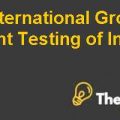
Winfield Refuse Management Inc.
Background
The report presents a case about Winfield Refuse Management Inc., which is a non-hazardous waste management company that is considering to acquire, Mott-Pliese Integrated Solutions (MPIS). The organization believes that the potential acquisition will improve the cost position of the company and will assist the organization to achieve economies of scale.
Previously, the company had a policy to avoid long-term debts but the management now considers to revise its policy and fund the potential strategies through debt finance. The board had a large discussion on the impact of debt or equity financing on the performance of the company.
Problem statement
The board is concerned about the adoption of appropriate financing fix, which will reduce the overall financing cost of the company and will increase its funds for distribution to shareholders. Further, the board also considers the suitability and feasibility of debt and equity finance regarding the operations of the business.
Annual Cash Outlays
- Bond issue
If the company finances its potential acquisition through debt then our analysis in Appendices 1 shows that, it will result in a total out flow of $176.49 million and if these out flows are discounted at the cost of debt then it will result in an NPV of $106.07 million.
It has been calculated by considering the interest payment net of tax over 15 years and an annual principal repayment of $6.25 million with a $37.5 million payment on maturity. Further, the interest payment is carried net of tax because the interest payment is a tax deductable expense in calculating taxable profits.
- Common stock issue
On the other hand, if the company finances its potential acquisition through common stock, then the results of our analysis in Appendices 1 shows that the company will have to suffer a total out flow of $237.5 million. In addition, if these out flows are discounted back to its present value, then it will result in an NPV of $125 million. The company expects to pay a dividend of 6% of the stock in future years.
Based on the results, it is financially viable for the company to finance its strategy through debt finance.
Response to each director’s assessment
- Andrea Winfield
Andrea believes that the stock issue is the low cost approach but in fact it is more expensive mode of financing because the shareholders retain a residual interest in the profits of the company. The funds of the potential acquisition can be utilized to pay interest and principal amount. Further, the interest will reduce the funds available for its distribution to shareholders but on the other hand it will also eliminate the negative impact on EPS and return on equity.
- Joseph Winfield
Joseph believes that the potential acquisition is going to finance its own acquisition through generating sufficient funds after tax but the debts outflow are only for a limited period of time whereas dividend payments are for an infinite period of time, which increases the need to pay the dividend on a continuous basis.
- Ted Kale
Ted was concerned about the undervaluation of shares and believed that it could undermine the worth of shareholders. Its statement was quite justifiable but it was not the only measurement tool, the price might be low because the transaction had been executed over the counter.
- Joseph Tendi
Joseph Tendi believes that the principal repayment is irrelevant to the discussion. Its statement is quite shocking because the principal and interest payment represents a substantial portion of total cash out flow, ignoring this will lead the company to dissatisfy its bond holders.
- James Gitanga
James believes that the financial position of the company is quite different from other players in the market. It will increase the possibility for the company to finance its potential strategies through debt financing. Further, it will also increase the chance for the company to raise finance at a reduced rate as comapred to its competitors because the balance sheet of the company justifies low gearing, which will increase the investor’s confidence.
Factors to consider while financing the potential acquisition
The results of our analysis in Appendices 1 shows that the financing through debt will result in an out flow of $106.07 million and equity financing will result in an out flow of $125 million, so it is finanacially viable to finance its strategy through debt finance.......................
This is just a sample partial case solution. Please place the order on the website to order your own originally done case solution.










